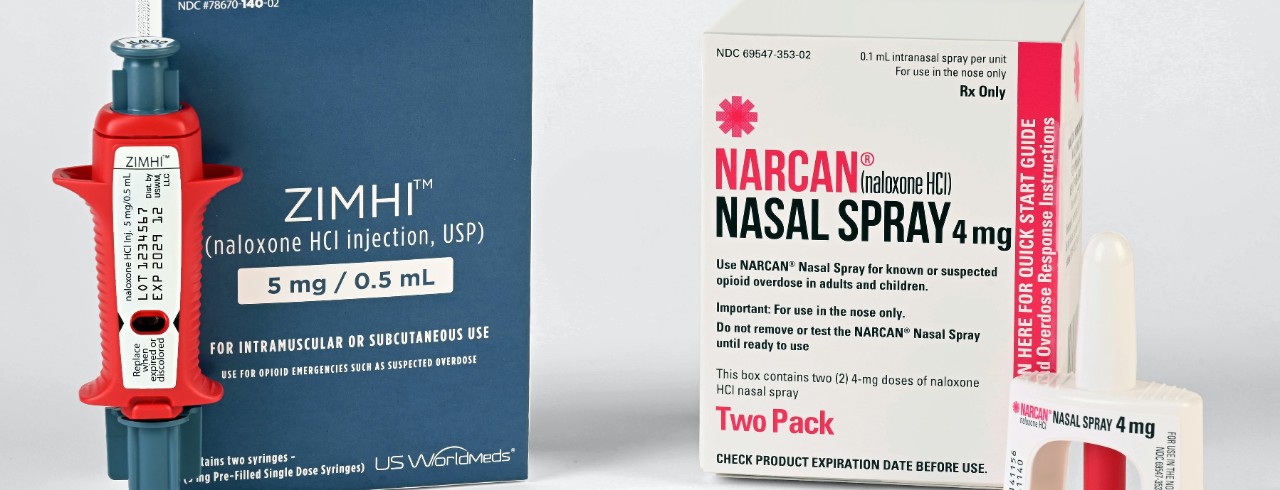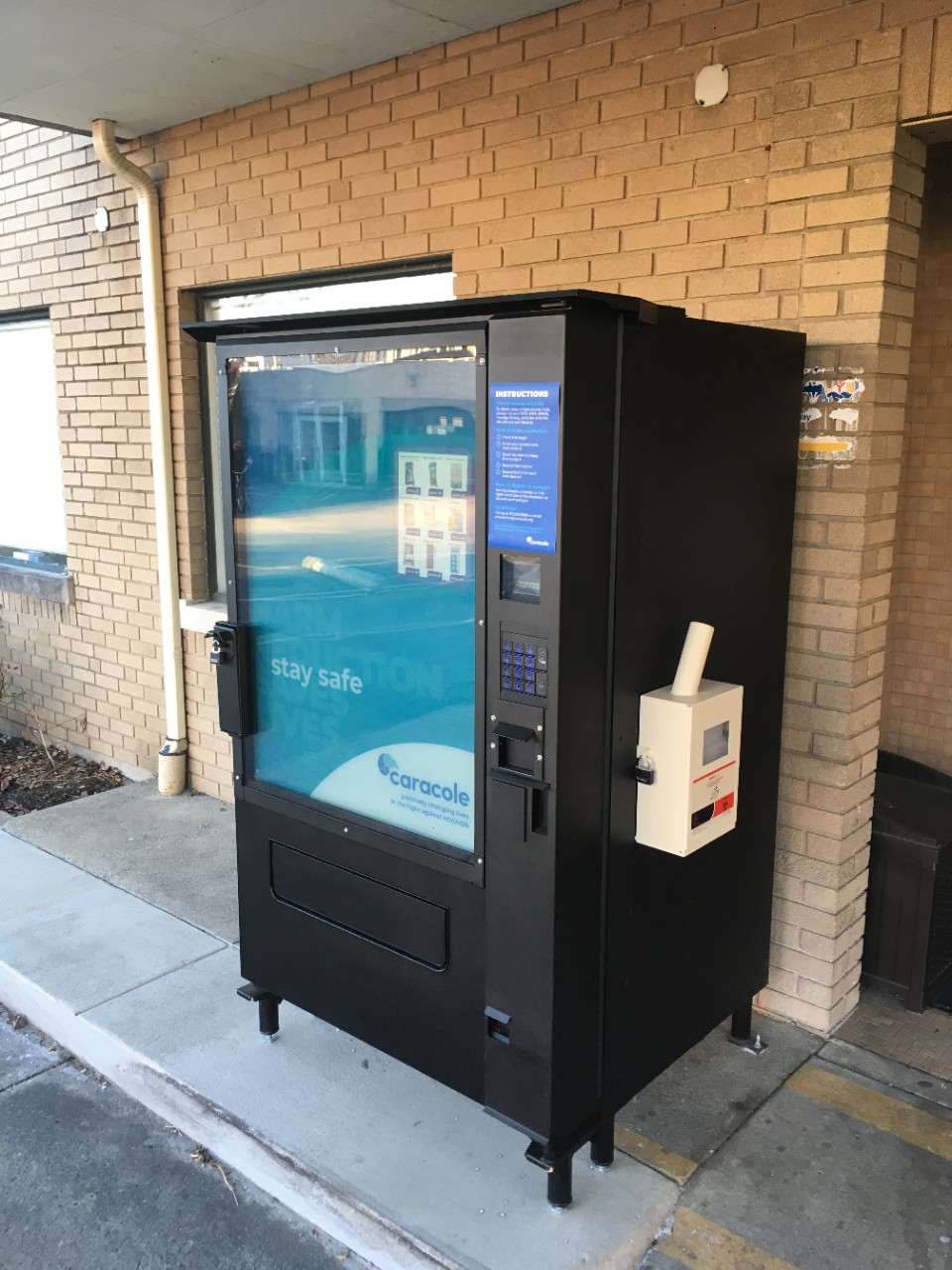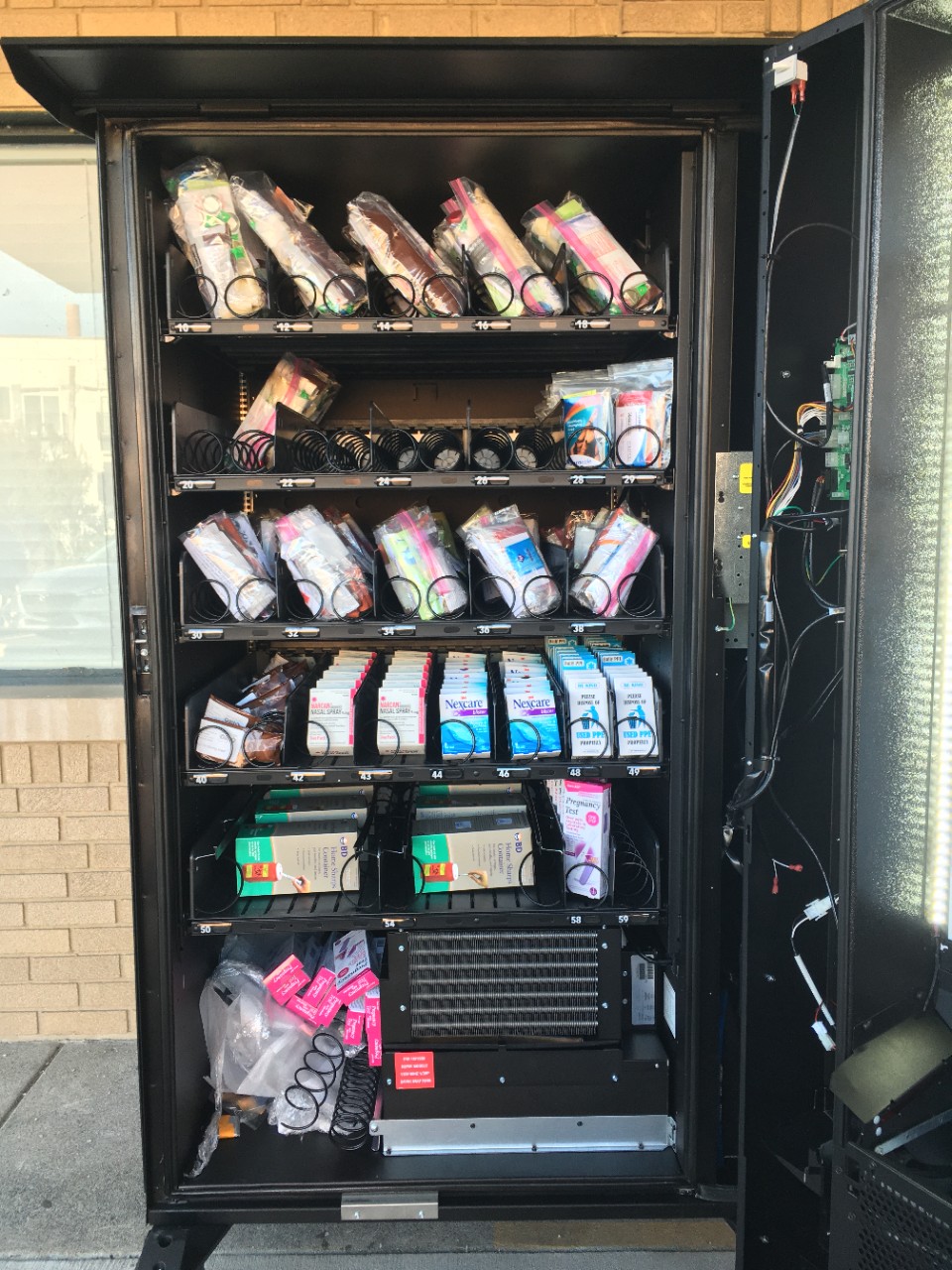
Nearly 1,000 overdoses reversed using naloxone distributed through vending machine
UC, Caracole partnership makes significant impact in Hamilton County
More than 107,000 Americans died from drug overdose in 2021, highlighting the need for evidence-based interventions.
New research from the University of Cincinnati, in partnership with local nonprofit Caracole, shows a self-service vending machine filled with harm reduction supplies such as naloxone helped prevent overdoses and contributed to Hamilton County’s overdose deaths decreasing in 2021.
The research, led by UC’s Daniel Arendt, Doctor of Pharmacy, was published Nov. 11 in the Journal of the American Pharmacists Association.
Harm reduction strategy

Daniel Arendt, PharmD. Photo/University of Cincinnati.
Arendt said harm reduction is a paradigm within drug and addiction education that recognizes that historically, people always have and will continue to use drugs. Harm reduction does not support or enable drug use, but instead aims to empathetically meet people where they are in the course of their drug use and help empower them to take steps which minimize the potential hazards associated with its use.
“If you are interested in stopping, we’re here to help,” said Arendt, assistant professor in UC’s James L. Winkle College of Pharmacy and co-chair of the pain stewardship committee for UC Health. “But if not, we aren't going to turn you away and refuse to help. We are going to work with you and help you take steps that will help keep you safe.
“Would it be ideal if everyone wanted to simply stop using drugs altogether? Yes, but that's not reflective of reality,” Arendt continued. “In the end, there isn't anything more you can do to help a person if they die from an overdose during the course of their use.”
In practice, Arendt said harm reduction efforts include distributing naloxone, the drug that can reverse an opioid overdose, as well as other supplies such as sterile syringes, fentanyl test strips, tourniquets and bandages.
“You would never tell someone who has wildly uncontrolled diabetes to get their blood sugar in check before we will help them or give them insulin,” Arendt said. “So it is critical to recognize that substance use is not a moral failing, and it’s not this thing that should be stigmatized. Instead, we can acknowledge that drug use is becoming increasingly risky, and we can use that recognition to help spur the development of new, innovative methods of providing people with the care, services and support that they need, no strings attached.”
A new approach

The harm reduction vending machine outside of Caracole is accessible 24/7 once a person has registered and received a code. Photo courtesy of Caracole.
Caracole, an HIV/AIDS service organization in Cincinnati, partnered with nonprofit Interact for Health to bring the idea of the vending machine to fruition, with an Interact for Health grant funding the purchase of the vending machine.
“A cornerstone of harm reduction is to help people who use drugs stay as healthy as possible,” Suzanne Bachmeyer, Caracole director of prevention, said. “Vending machines provide 24/7 ready access to life-saving and disease prevention supplies so people feel empowered to take control of their health. People can’t get healthy or seek treatment if they aren’t alive.”
After the machine was purchased by Caracole, Arendt was brought on board the project to assist with data collection and monitoring. He said the partnership began after meeting Bachmeyer and her colleagues at a Hamilton County Addiction Response Coalition meeting.
Self-service syringe vending machines have been used for decades in other parts of the world, with research showing a positive impact, but Arendt said the only operating harm reduction vending machines in the United States prior to their efforts were located in Las Vegas and Puerto Rico.
“So our thought process was why not here, why not us, why not Cincinnati. Just because this hasn’t been done in the U.S. doesn’t mean it can’t be done in the U.S., so let’s bring it here and show that this is not just something that works in Europe, but this is something that works here,” Arendt said.
The machine was placed outside of Caracole’s building on Hamilton Avenue in Cincinnati in February 2021 and is accessible 24/7. Program participants enroll by calling Caracole and completing an anonymous survey, after which they receive an access code that is good for 90 days. Clients can reenroll every 90 days after initially joining the program to continue using the machine.
When enrolling, harm reduction counselors offer additional information on topics including HIV and hepatitis C prevention and testing information, local housing programs, counseling, substance use disorder medical treatment and prenatal care.
Each person with a code can dispense two injection doses of naloxone, two nasal spray doses of naloxone, a container for disposing of sharp objects such as needles, a safer injection kit, a safer smoking kit, a personal protective equipment kit, a safer sex kit, a pregnancy test and a box of bandages from the machine every seven days.
Ohio law requires local jurisdictional approval for syringe service programs that distribute sterile syringes and other harm reduction supplies, and the team was not permitted to include sterile syringes in the machine.
Program results

The vending machine is stocked with harm reduction supplies including doses of naloxone, safer injection kits, safer smoking kits and bandages. Photo courtesy of Caracole.
Through the first year after the machine was installed, it dispensed 3,360 doses of naloxone and 10,155 fentanyl test strips. A total of 911 people have used the machine since it was installed, nearly 16% of whom reported they had never used harm reduction services before.
Even without being able to distribute syringes, the vending machine became the largest harm reduction supplier in the county compared to other in-person syringe service programs.
“I think it was really striking to see just how much use it got almost immediately compared to other in-person syringe service programs,” Arendt said. “Recognizing how many people were out there looking for something like this or needing something like this was really surprising.”
When people called after 90 days to reenroll in the program, Arendt said it gave an opportunity to see how the supplies dispensed from the machine were actually used. Out of 124 people who reenrolled, 71% reported using naloxone from the machine to reverse an overdose.
At the time the study was published, clients reported 288 overdoses were reversed with naloxone from the machine. Arendt said the latest numbers show that naloxone from the machine has been used to reverse an overdose 960 times.
More than two-thirds of reenrollees reported detecting fentanyl within their drug supply. Clients either threw away the supply or used a lower dose 75% of the time that fentanyl was detected.
While national overdose deaths increased by 15% in 2021, Hamilton County reported a 10% decrease. Arendt said while there are too many variables to claim the vending machine was solely responsible for this decline, he believes it did have a sizable impact.
Making sure that everyone who’s a pharmacist is aware of what is needed, what they can do, what support they can provide and how that can be beneficial I think will only increase the accessibility of support services for everyone.
Daniel Arendt, PharmD
“So not only was this a relatively novel concept, but it showed that even when you’re not able to include syringes, including these other things in the vending machine is helpful enough on its own,” Arendt said. “That is not to say that we shouldn’t also want syringes and all the possible products available, but more just to say that even in states where that is too much of a legal hurdle for you to get through, you can still have an intervention that is safe and effective.”
Black participants make up about 2% of Caracole’s in-person syringe service program, while about 6% of vending machine users in the first year were Black. While the machine represented an improvement in more equitably distributing harm reduction materials, Arendt said current efforts aimed at underrepresented populations are “not adequate” and there is more work to be done.
Next steps
The Center for Clinical and Translational Science and Training at the University of Cincinnati and Cincinnati Children’s Hospital Medical Center recently awarded Arendt and the Caracole team with the Academic-Community Research Partnership Award for their work on the vending machine program. The award honors an academic-community partnership that works collaboratively to facilitate innovation in research or quality improvement to impact the health of children, adults and/or communities in the Greater Cincinnati/Northern Kentucky region.
Arendt and Caracole staff members have been working with other organizations across the state and country to implement more harm reduction vending machines. A vending machine is already up and running in Brown County, Ohio, with Hamilton County Public Health currently searching for locations for additional machines outside of the Caracole location.
In partnership with UC’s Claudia Rebola, PhD, and the UC Venture Lab, Arendt is also working to develop a wearable device that can detect that an overdose is occurring and alert people in a person’s support network such as a partner, friends or family so that they can respond with naloxone.
Arendt said he also sees an expanded role for pharmacists in harm reduction efforts, as they are the experts when it comes to drugs. Pharmacists are historically the most accessible health care profession, so they need to be equipped and comfortable in providing advice and assistance to people with substance use disorders and recreational drug users, Arendt said.
“We as pharmacists are the experts to be able to be there to provide resources to keep people healthy and safe regardless of if a drug was prescribed or obtained illicitly,” Arendt said. “Making sure that everyone who’s a pharmacist is aware of what is needed, what they can do, what support they can provide and how that can be beneficial I think will only increase the accessibility of support services for everyone.”
Impact Lives Here
The University of Cincinnati is leading public urban universities into a new era of innovation and impact. Our faculty, staff and students are saving lives, changing outcomes and bending the future in our city's direction. Next Lives Here.
Featured photo at top of naloxone doses courtesy of Unsplash.
Arendt has no relevant conflicts of interest to report or financial relationships with ineligible companies to disclose.
Related Stories
NIH grant funds HIV research
November 2, 2022
A collaborative research team at the University of Cincinnati has received a $3.5 million National Institutes of Health grant to examine how current HIV medications are affected by alcohol use alone or in combination with fentanyl.
Washington Post: What you need to know about the dry shampoo...
October 26, 2022
The University of Cincinnati's Kelly Dobos was featured in a Washington Post article about the recent recall of more than a dozen dry shampoos due to the possibility they contain “elevated levels” of benzene.
Improving outcomes for injured soldiers
August 10, 2022
University of Cincinnati researchers Jason Gardner and Matthew Robson are studying whether targeting an inflammation pathway that affects burns and traumatic brain injuries can be an effective treatment for both conditions.
